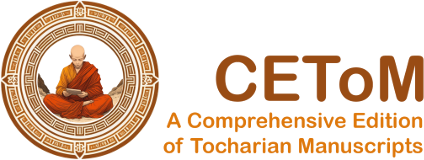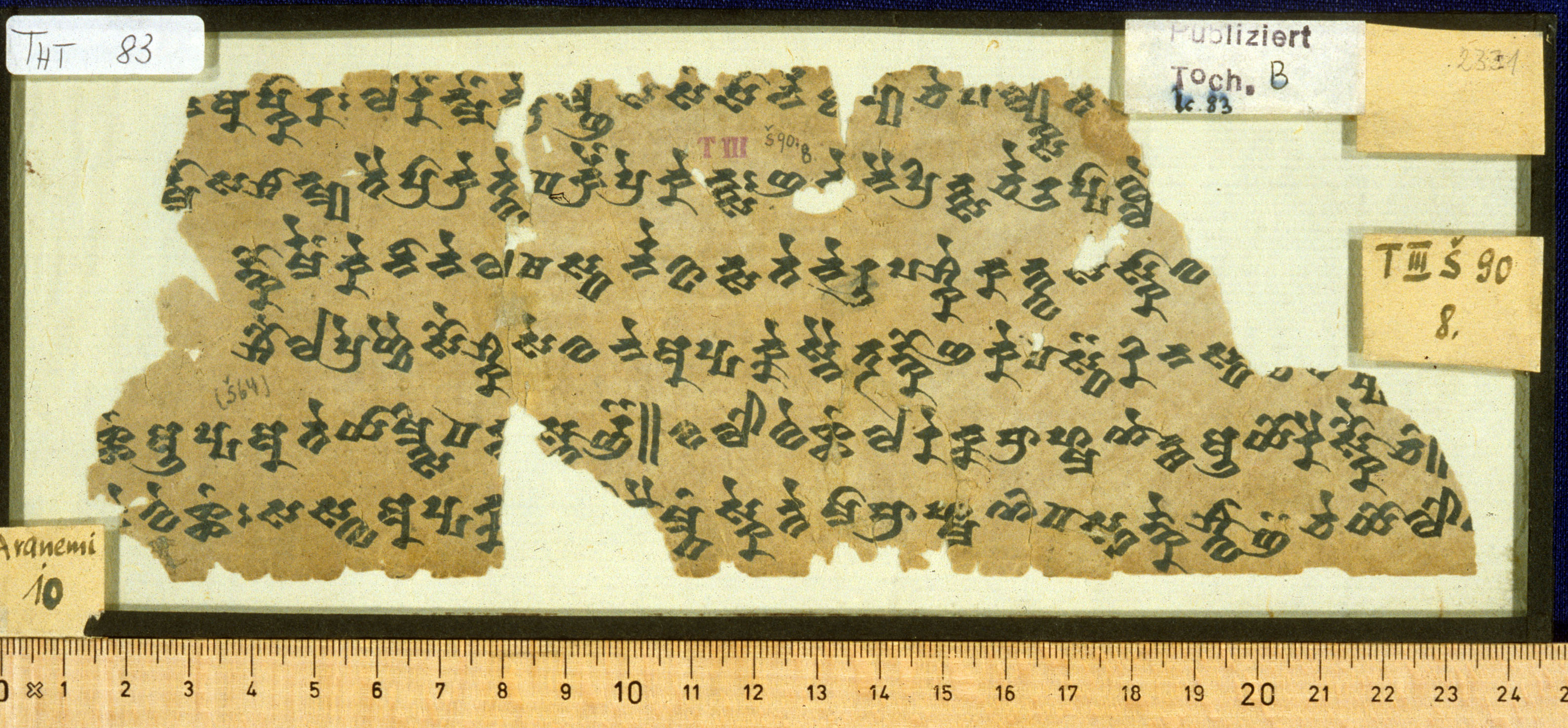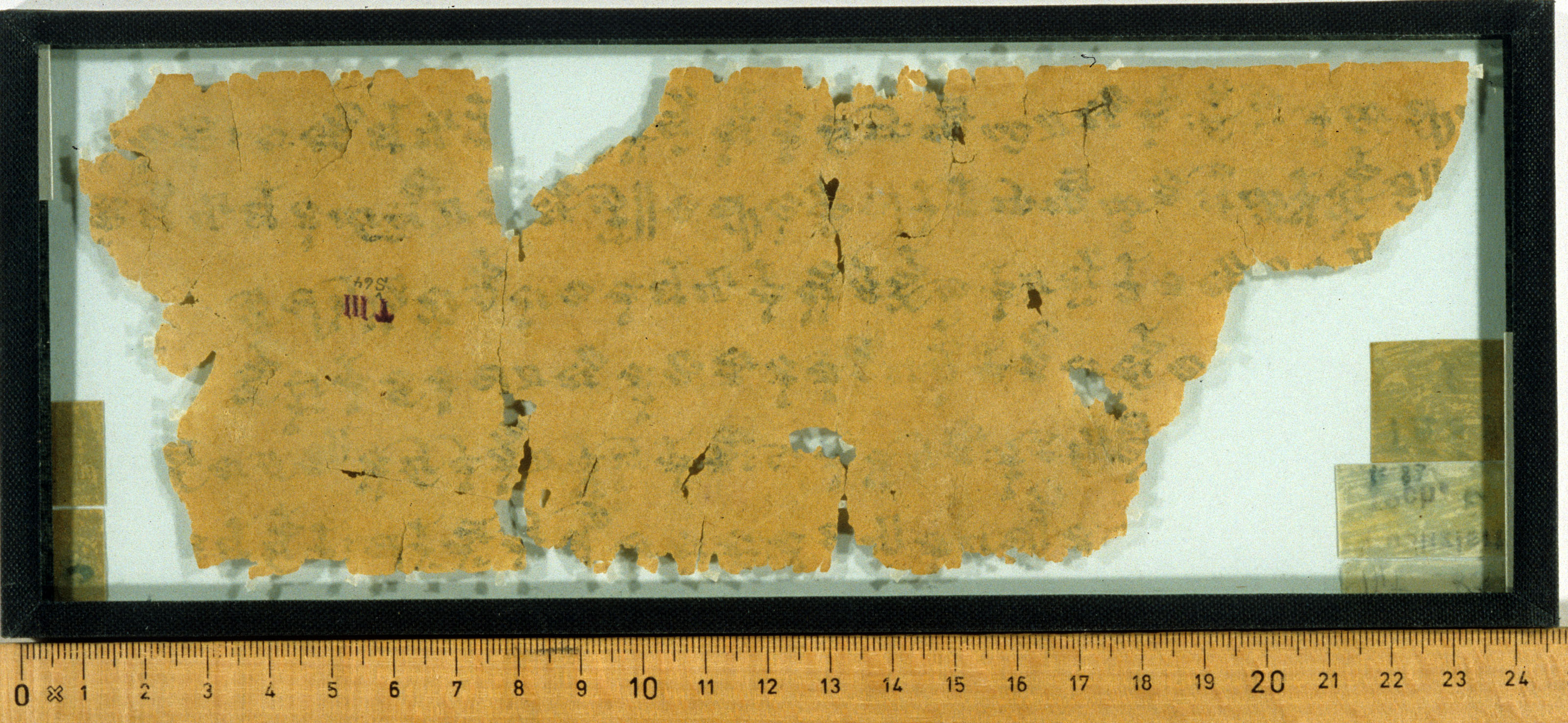THT 83
| Known as: | THT 83; B 83; Bleistiftnummer 2331 |
|---|---|
| Cite this page as: | Melanie Malzahn. "THT 83". In A Comprehensive Edition of Tocharian Manuscripts (CEToM). Created and maintained by Melanie Malzahn, Martin Braun, Hannes A. Fellner, and Bernhard Koller. https://cetom.univie.ac.at/?m-tht83 (accessed 14 Jul. 2025). |
Edition | |
| Editor: | Melanie Malzahn |
Provenience | |
| Main find spot: | Shorchuk |
| Expedition code: | T III Š 90.8 |
| Collection: | Berlin Turfan Collection |
Language and Script | |
| Language: | TB |
| Linguistic stage: | classical |
| Add. linguistic characteristics: | late; hypercorrect |
| Script: | classical |
Text contents | |
| Title of the work: | Araṇemijātaka |
| Text genre: | Literary |
| Text subgenre: | Jātaka/Avadāna |
| Verse/Prose: | prose; verse |
| Meter: | 665 (4x) |
Object | |
| Manuscript: | Araṇemi α |
| Preceding fragment: | THT 82 |
| Following fragment: | THT 84 |
| Material: | ink on paper |
| Form: | Poṭhī |
| Number of lines: | 6 |
Images
Images from idp.bl.uk by courtesy of the International Dunhuang Project, the Berlin-Brandenburgische Akademie der Wissenschaften, and the Staatsbibliothek zu Berlin – Orientabteilung.
Transliteration
(continues from THT 82)
| a1 | /// [n](·) a ṣkā r[o] : la reṃ nmeṃ t[s]re lñ(·) s(·) saṃ sā rn(·) [ka] py· ce p(·) lyks(·) t(·) – /// |
|---|---|
| a2 | /// nmau sa śā nmya tai prā kre twe pa rkreṃ pre ke ntsa : ña [k]e nai pri ntsa rce u ppā lle /// |
| a3 | /// ○ ṅko rmeṃ ke nī ne la ma sta rne au tsa te ne ru pa śke ka ntwa s(·) skā w[a] /// |
| a4 | /// ○ śau la pre ñcai sau śka se wa te a ppa kke snai tra ṅko ña ke pa¯ ¯stä ri na sta(·) [c](·) t(·) ṣp(·) /// |
| a5 | /// s̝s̝aṃ ā ppa a te yā mtsi pa [kn](·) s[ta]¯ ¯rñä || wa lo we s̝s̝aṃ la re kka brā hma ṇe¯ ¯ts ā yo rai skau¯ ¯c• || /// |
| a6 | /// [n]e we s̝s̝aṃ : sa swa a ppa kka (–) (·)[ī] [c]ai¯ ¯mp• ske nte mā brā hma ṇi pa¯ ¯st ṅke śwā¯ ¯ñä ce yo lo – /// |
(continues on THT 84)
Transcription
(continues from THT 82)
| Xx | 14σ /// n· aṣkāro : |
|---|---|
| Xx | lareṃnmeṃ tsrelñ(e)s(a) ; saṃsārn(e) kä(r)py(eṃ) ce ; p(a)lyks(a)t(ai) (twe) (no) |
| Xx | /// a2n2n3 3σ /// (śa)nmausa ; śānmyatai prākre twe ; pärkreṃ prekentsa : |
| Xx | ñake nai printsar ce ; uppāl le /// 8σ |
| a3 | n4n5 /// (e)ṅkormeṃ kenīne lamästär-ne autsate-ne rupaśke kantwas(a) skāwa(tsi) /// |
|---|---|
| a4 | n6 /// śaula-preñcai s{au→oṃ}śka se wate appakke snai träṅko ñake päst rinastä(r)-c ·t· ṣp· /// |
| a5 | n6 /// (we)ṣṣäṃ āppa ate yāmtsi päkn(ā)star-ñ ॥ walo weṣṣäṃ larekka brāhmaṇets āyor aiskau-c ॥ /// |
| a6 | n7 /// ne weṣṣäṃ : saswa appakka (yakṣ)ī caimp skente mā brāhmaṇi päst ṅke śwā-ñ ce yolo – /// |
(continues on THT 84)
Translation
(continues from THT 82)
| a1 | (The king says to himself:) ... (you were held) back; by separation from [your] loved ones you were tormented in this common saṃsāra. .... |
|---|---|
| a2 | ... With the bonds of ... you were bound through long ages. Now give up this lotus(-like) (?) [son] ... ! ... |
| a3 | .... having (s)eized (the son), he sets him upon his knees [and] began (to) kiss [his] little face with [his] tongue. ... |
| a4 | ... “You, my life-bearing dear son! This one there is [your] second dear father, [a dear father] without ill will. Now (your first father) leaves you.” ... |
| a5 | ... (The prince Uttara spe)aks: “Father, do you intend to give me away?” The king speaks: “My darling! To the Brahmins I give you as a gift!” .... |
| a6 | .... (The prince Uttara) speaks: “My dear lord father! (Yakṣa)s those are, [they are] not Brahmins! They will surely eat me up! To these evil .... |
(continues on THT 84)
Other
| a2 | Mit der ...-Fessel warst du gefesselt ... (Schmidt 1974: 257, fn. 1) |
|---|---|
| a3 | ... (den Prinzen Uttara) ergriffen habend, setzt er [scil. König Araṇemi] ihn auf [seine] Knie [und] begann, sein Gesichtchen mit der Zunge zu küssen. (Schmidt 1974: 369) |
Commentary
Philological commentary
| The translation follows Schmidt 2001: 312. In Sieg and Siegling 1953: 21 the first two lines are interpreted as a soliloquy by the king, as a “Zwiegespräch mit dem eigenen Ich” (i.e. “dialogue with the inner self”; Thomas 1957: 185). | |
| n1 | Sieg/Siegling propose to read and restore kä(r)py(eṃ) "common", cf. kärpye-saṃsār in IOL Toch 1 b 4; but there is a trace of the vowel sign left that can only be ā, o, or au, cf. Schmidt 2001: 312, fn. 56, who, nevertheless, accepts the correction to kä(r)py(eṃ). The middle Pt III form p(·)lyks(·)t(·) has to be restored to a zero-grade form p(a)lyks(a)t(ai); see Hackstein 1995: 111, fn. 6 with ref. At the end, Sieg/Siegling restored (twe no), TEB II: 50, fn. 7 (twe ṣek). |
| n2 | The meter has 4 x 17 (6/6/5) syllables. |
| n3 | TEB II: 50, fn. 8 also propose the word separation uppāll e, and even though words starting with le are rare (none fits here), such a gemination in sandhi is unusual. Sandhi gemination is usually found at morpheme boundaries, but, to my knowledge, not in compounds (the form may be one). |
| n4 | Note the tense alternation between present and preterite. |
| n7 | At the beginning, TEB II: 51, fn. 3 propose to restore the m-Part. (miwama)ne "trembling". As for the restoration of the lacuna, Sieg/Siegling in Sieg and Siegling 1953: 21, fn. 14 propose the nom.pl. yākṣi (as attested in THT 3 a 1), reading two completely missing akṣaras. In contrast, TEB II: 51, fn. 4 restore yakṣī based on THT 85 a 3/4. Then Thomas in Sieg and Siegling 1983: 238 withdraws this interpretation, arguing for yākṣi again. However, there is a trace of the vowel sign left, which can only belong to a long ī, not to a short one. |
Remarks
| Fragment of one side of a leaf, probably the verso of the leaf directly following THT 82, so originally leaf 17 of the manuscript. |
Linguistic commentary
| n5 | There is no trace of an anusvara on either autsate-ne (for auntsate) in line 3 or brāhmaṇets (for brāhmaṇeṃts) in line 5, so that Sieg/Siegling restore one in both cases; however, these are rather instances of genuine nasal loss in front of ts, which is a feauture of late and colloquial texts; see Peyrot 2008: 69. |
|---|---|
| n6 | The reading sauśka for soṃśka is certain; a similar form sauśke is found on the following leaf THT 84 b 6. Even though the graphemes oṃ and au look quite similar, the two spellings are most likely not simply due to copyist errors but are rather hypercorrect spellings, since in the late/colloquial language the sequence oṃś turns to auś; see Peyrot 2008: 91-93. |
Alternative linguistic/paleographic classifications
| Tamai 2011 | C5 |
| Tamai 2011 | C14 |
References
Miscellaneous
Online access
Edition
Translations
Carling 2000: a3 (215); Couvreur 1954c: a1 a2 a3 a4 a5 a6 (101); Hackstein 1995: a1 (111), a5 (252); Krause 1952: a1 (40), a5 (204), a5 (206), a6 (204); Schmidt 1974: a2 (257 n.1), a2 (257, fn. 1), a3 (369); Schmidt 2001: a1 a2 a3 a4 a5 a6 (312); Sieg and Siegling 1983: a4 (238); Thomas 1952: a1 (55); Thomas 1957: a1 (185), a2 (185, 208), a5 (243 n.3); Thomas 1988: a3 (252)
Bibliography
Carling, Gerd. 2000. Die Funktion der lokalen Kasus im Tocharischen. Berlin/New York: de Gruyter.
Couvreur, Walter. 1954c. “Koetsjische literaire fragmenten uit de Berlijnse verzameling (naar aanleiding van Sieg & Siegling’s Tocharische Sprachreste).” Handelingen VIII der Zuidnederlandse Maatschappij voor Taal- en Letterkunde en Geschiedenis, 97–117.
Hackstein, Olav. 1995. Untersuchungen zu den sigmatischen Präsensstammbildungen des Tocharischen. HS Erg.-Heft 38. Göttingen: Vandenhoeck & Ruprecht.
“The International Dunhuang Project: The Silk Road Online.” n.d. http://idp.bl.uk.
Krause, Wolfgang. 1952. Westtocharische Grammatik, Band I. Das Verbum. Heidelberg: Winter.
Peyrot, Michaël. 2008. Variation and change in Tocharian B. Vol. 15. Leiden Studies in Indo-European. Amsterdam/New York: Rodopi.
Schmidt, Klaus T. 1974. “Die Gebrauchsweisen des Mediums im Tocharischen.” PhD, Universität Göttingen.
Schmidt, Klaus T. 2001. “Die westtocharische Version des Araṇemi-Jātakas in deutscher Übersetzung.” In De Dunhuang à Istanbul. Hommage à James Russell Hamilton, edited by Louis Bazin and Peter Zieme, 299–327. Silk Road Studies 5. Turnhout: Brepols.
Sieg, Emil, and Wilhelm Siegling. 1953. Tocharische Sprachreste. Sprache B, Heft 2. Fragmente Nr. 71-633. Edited by Werner Thomas. Göttingen: Vandenhoeck & Ruprecht.
Sieg, Emil, and Wilhelm Siegling. 1983. Tocharische Sprachreste. Sprache B. Teil I: Die Texte. Band 1. Fragmente Nr. 1-116 der Berliner Sammlung. Edited by Werner Thomas. Neubearbeitet und mit einem Kommentar nebst Register versehen v. Werner Thomas. Göttingen: Vandenhoeck & Ruprecht.
Tamai, Tatsushi. 2011. Paläographische Untersuchungen zum B-Tocharischen. Innsbrucker Beiträge zur Sprachwissenschaft 138. Innsbruck: Institut für Sprachen und Literaturen.
Thomas, Werner, and Wolfgang Krause. 1964. Tocharisches Elementarbuch, Band II. Texte und Glossar. Heidelberg: Winter.
Thomas, Werner. 1952. Die tocharischen Verbaladjektive auf -l. Deutsche Akad. der Wissenschaften zu Berlin, Institut für Orientforschung 9. Berlin: Akademie-Verlag.
Thomas, Werner. 1957. Der Gebrauch der Vergangenheitstempora im Tocharischen. Wiesbaden: Harrassowitz.
Thomas, Werner. 1988. “Toch. AB säm-/läm- ‘sitzen’ in transitivem Gebrauch.” Central Asiatic Journal 32: 244–59.
Gippert, Jost, Katharina Kupfer, Christiane Schaefer, and Tatsushi Tamai. n.d. “Thesaurus Indogermanischer Text- und Sprachmaterialien (TITUS): Tocharian Manuscripts from the Berlin Turfan Collection.” http://titus.fkidg1.uni-frankfurt.de/texte/tocharic/thtframe.htm.




